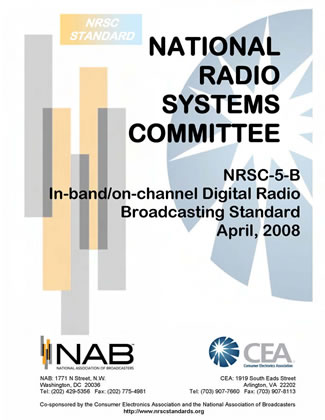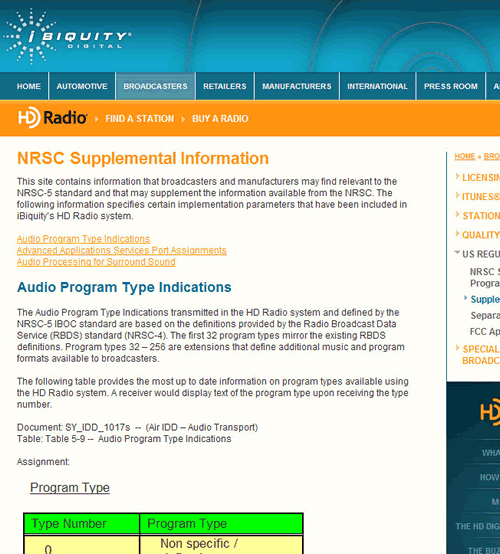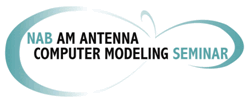|
Updated
NRSC-5 Standard Published
 The
National Radio Systems Committee (NRSC) has now published the
NRSC-5-B In-band/on-channel Digital Radio Broadcasting Standard
which was adopted by the Digital Radio Broadcast (DRB) Subcommittee
at the April 12, 2008 meeting of the group (held in Las Vegas
in conjunction with the 2008 NAB Show). This document and the
associated reference documents are available for download free
of charge at www.nrscstandards.org/SG/NRSC-5-B.asp. The
National Radio Systems Committee (NRSC) has now published the
NRSC-5-B In-band/on-channel Digital Radio Broadcasting Standard
which was adopted by the Digital Radio Broadcast (DRB) Subcommittee
at the April 12, 2008 meeting of the group (held in Las Vegas
in conjunction with the 2008 NAB Show). This document and the
associated reference documents are available for download free
of charge at www.nrscstandards.org/SG/NRSC-5-B.asp.
First
adopted in April 2005 then revised in September 2005 (as NRSC-5-A),
this Standard sets forth the requirements for broadcasting digital
audio and ancillary data signals in the AM and FM radio bands.
It is structured as a main document (the Standard itself, cover
shown in image at right) which provides an overview of the AM
and FM IBOC systems designed by iBiquity Digital Corporation (and
upon which the Standard is based), and a set of reference documents
authored by iBiquity (with input from the NRSC) which provide
the detailed information needed for those “skilled in the
art” to construct compatible equipment. NRSC-5-A differed
from the original document in that it specified a mechanism for
transmission of advanced data services.
This
latest version includes substantive (but relatively minor) changes
as well as editorial revisions designed to make the document easier
to understand and more complete. None of these changes are expected
to cause any backwards compatibility issues with HD Radio receivers.
Some of the more significant changes are highlighted here (section
numbers refer to sections in NRSC-5-B):
Table
of Contents – tables listing all of the Figures and Tables
in the Standard are now included; also, Table 5 (description of
information transmitted by SIS) has been augmented to include
all types of SIS data;
Section
3.3.2 – Data Inputs – this section was edited to
make clearer the different types of data supported by the system.
While the previous version discussed only two types of data—program
service data (PSD) and non-program service data—the updated
version makes clear the fact that the system supports three distinct
data services:
- PSD,
which includes descriptive information associated with the
transmitted audio programming such as song title and artist;
- Station
Information Service (SIS) data, which contains information
about the station and the signal that is not associated with
an individual program stream; and,
- Advanced
Data Services (ADS) data, which is data that is sent using
the ADS portion of the system (examples would include navigation/traffic
information, image files of CD covers, etc.).
Section
4.1.8 – Spectrum Emission Limits for AM IBOC –
this is a new section which includes and augments information
from Section 4.1.7 of the previous version (the AM IBOC mask itself
is unchanged). A new sub-section, 4.1.8.1 – Measurement
of mask compliance for AM IBOC systems, references
an NRSC Guideline which is currently under development by the
NRSC’s IBOC Standards Development Working Group (ISDWG).
This Guideline will include detailed mask compliance measurement
procedures applicable to different types of measurements (e.g.,
factory test, in-service out-of-band emissions), as well as recommended
locations for making measurements depending upon the specifics
of a particular implementation. The ISDWG expects to complete
this new Guideline later this year.
Section
4.2.8 – Spectrum Emission Limits for FM IBOC –
the FM hybrid IBOC spectrum emission mask has been modified from
the previous versions and is included in this section. This is
a minor modification (a relaxation of the mask in the region from
200-250 kHz offset from the channel center frequency) which was
previously submitted to the FCC by iBiquity Digital Corporation
in July, 2006. The modified mask is shown in Figure 19 - NRSC-5
FM hybrid waveform noise and emission limits. Additional
changes here are similar to those discussed for Section 4.1.8
above.
Section
5.3 – Advanced Data Services – new text in
this section clarifies the definition and function of the Advanced
Applications Services Transport (AAT). AAT is the method chosen
by the NRSC for transport of fixed and opportunistic advanced
data services (ADS) data in the IBOC system (AAT was first included
in the NRSC-5-A version of the Standard).
Reference
document 1011s rev. F – the most important change here
is the substitution of extended hybrid service mode MP4 with a
new mode, MP11. The new service mode has the same approximate
information rate as did the old (148 kbps) but the bits are allocated
differently among the various logical channels, and a potential
backwards compatibility issue (identified by iBiquity  since
adoption of NRSC-5-A) is resolved. In addition, this revision
of 1011s removes an interleaver definition which was found to
cause delay in audio and data, leaving a single interleaver definition
instead of two. since
adoption of NRSC-5-A) is resolved. In addition, this revision
of 1011s removes an interleaver definition which was found to
cause delay in audio and data, leaving a single interleaver definition
instead of two.
Coincident
with the adoption of this most recent version of the Standard,
iBiquity has launched an “NRSC Supplemental information”
Web page (see image at right) which will allow iBiquity to provide
HD Radio system information to broadcasters and manufacturers
that has not yet been incorporated in the Standard. Included here
at present is information about:
- Audio
Program Type – lists the codes for program formats
(e.g., sports, talk, etc.) which have been added since adoption
of the Standard (type numbers 32-54 shown here are new);
- AAT
port assignments – provides new information about
the "port identifiers" required for each advanced
data service;
- Surround
sound codes – iBiquity has assigned a unique code
to various surround sound formats which can be used with
the HD Radio system.
This
Web page can be accessed directly at www.ibiquity.com/broadcasters/us_regulatory/nrsc_supplemental_information
or through links provided on the NRSC-5-B Web page.
 NAB
AM Antenna NAB
AM Antenna
Computer Modeling Seminar
November 20-21, 2008
NAB Headquarters
Washington, DC
Don’t miss this opportunity for broadcast engineers to learn
the basics needed to utilize modeling software such as MININEC
and nodal analysis for designing performance-optimized AM directional
antenna phasing and coupling systems and proving the performance
of directional antenna patterns.
You
will learn about:
-
Moment
Method Modeling Basics
-
DA
Proofing Using Moment Method Modeling
-
Overcoming
Limitations of Using Field Strength Measurements for DA Proofs
-
State
of the Art in Phasing System Design Nodal Analysis of AM DA
Phasing and Coupling Systems
-
Pattern
Design Considerations for Optimum Performance
AM
antenna experts Ron Rackley and Ben Dawson, along with antenna
modeling software specialist Jerry Westberg, will lead the seminar
demonstrating how moment method modeling makes analysis of actual
tower current distributions possible and how a model can be used
to proof an array provided the proper criteria are considered.
All instructors are well known in the radio industry as experts
in the field of directional antenna design and maintenance. Their
decades of experience offer station engineers an opportunity to
learn techniques, tips and tricks that can be immediately useful.
Seminar
fee: $395.00 (NAB members) and $495.00 (non-members). For
more information on the curriculum, how to register or housing
go to AM
DA Seminar on the NAB Web site or call Sharon Devine at (202)-429-5338.
Register now for the NAB AM Antenna Computer Modeling Seminar!


The
June 2, 2008 Radio TechCheck is also available
in an Adobe Acrobat file.
Please
click
here to read the Adobe Acrobat version of Radio TechCheck.
|

